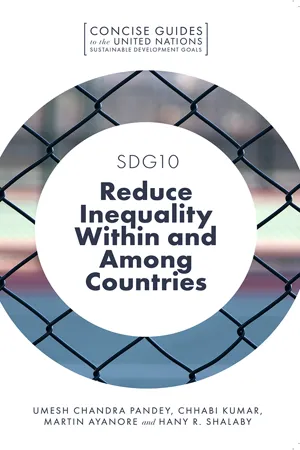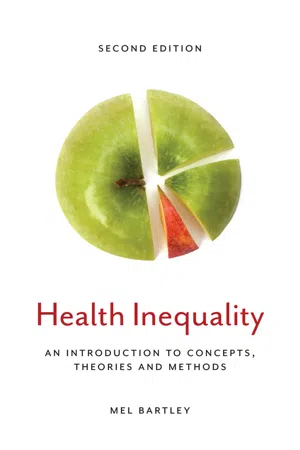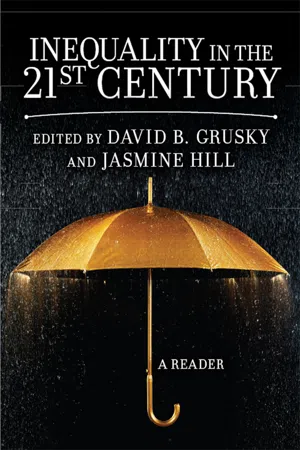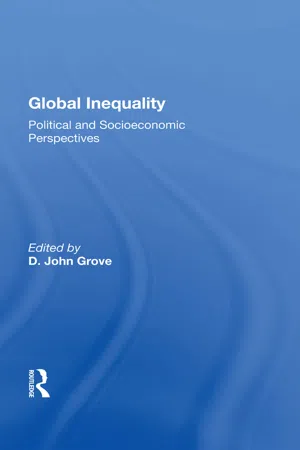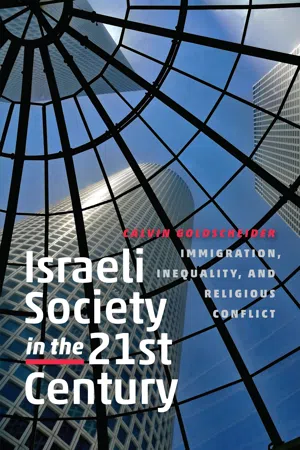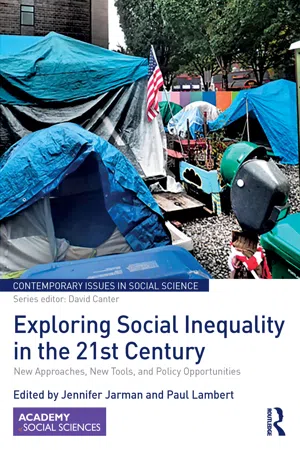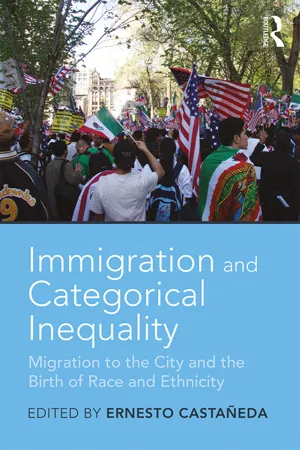Social Sciences
Ethnic Inequality
Ethnic inequality refers to disparities in opportunities, resources, and treatment experienced by different ethnic groups within a society. This can manifest in various forms, such as unequal access to education, employment, healthcare, and political representation. Ethnic inequality is often rooted in historical and systemic discrimination, and addressing it requires understanding and addressing the complex interplay of social, economic, and political factors.
Written by Perlego with AI-assistance
Related key terms
8 Key excerpts on "Ethnic Inequality"
- Umesh Chandra Pandey, Chhabi Kumar, Martin Ayanore, Hany R. Shalaby(Authors)
- 2020(Publication Date)
- Emerald Publishing Limited(Publisher)
Though income inequality is an important factor in determining the non-income outcomes of well-being such as health, nutrition and education, it is not the only factor which leads to inequalities in non-income outcomes (UNDP, n.d.). Citing several studies, the UNDP states that the role of institutions (e.g. inefficient or ineffective service delivery and distribution systems), governance failures (e.g. corruption, red-tapism and absence of the rule of law) and public policy shortcomings (for instance public expenditure biases that favour the privileged class) are the critical factors of inequalities in the non-income aspects of material well-being.INEQUALITY RESULTING FROM ETHNICITY DISCRIMINATION
Discrimination on the basis of ethnicity has a long global history. Whether it be the ethnic cleansing of Jews during the period of the Second World War or the Bosnian genocide, ethnicity discrimination has been the major cause of some of the worst crimes against humanity. The Merriam Webster dictionary relates the word ethnic as of or relating to large groups of people classed according to common racial, national, tribal, religious, linguistic, or cultural origin or background .As stated earlier, discrimination based on the birth of an individual creates conditions of deprivation and inequality of opportunities along with unequal control and access to various resources. This further has a great bearing on the realisation of the full potential of any individual, thus creating a cycle of deprivation. In certain cases, discrimination against a particular ethnic group has culminated in systematic uprooting and genocide against the community. This has adverse consequences not only for the targeted community but for the nation as a whole, seriously threatening its social fabric the overall well-being of the individual.Alesina, Michalopoulos, and Papaioannou (2014) have cited various research references to prove that ethnic disparities are likely to lead to political inequality based on ethnic affiliation, thereby increasing group animosity among various communities and to discriminatory policies. Inequality across ethnic lines has also been linked to the under-provision of public goods, impeding institutional development and the consolidation of democratic institutions. Empirical research also links socioeconomic ethnic-group inequalities to reduced government quality. According to the authors, there is evidence to show that the presence of an economically dominant ethnic minority may have an inverse impact on the support for democracy and free-market institutions. This is attributed to the fact that often the majority ethnic group may usually feel that the benefits of capitalism and the free-market economy might just go to a small percentage of the population. Ethnic Inequality implies that the overall well-being of an individual depends on one’s ethnic identity. This feeling is more likely to generate a perception that the existing state of affairs is biased and this may in turn reduce interpersonal trust.- eBook - ePub
Inequality in U.S. Social Policy
An Historical Analysis
- Bryan Warde(Author)
- 2021(Publication Date)
- Routledge(Publisher)
CHAPTER 3 Social InequalityDOI: 10.4324/9781003023708-3WHAT IS SOCIAL INEQUALITY?Social inequality is complex and multidimensional. It involves the unequal allocation or denial of society’s resources, rights, goods, privileges, and services across socially defined and stratified categories (Massey, 2007; Ridgeway, 2014; Warwick-Booth, 2013). Socially defined and stratified categories include factors such as one’s race/ethnicity, gender, social class, immigration status, sexual orientation/identity, and disability status. Society’s resources, rights, goods, privileges, and services include but are not limited to education; health care; employment; income; wealth; housing; and social, political, and economic justice. Social inequality affects the quality of life of individuals, groups, and populations, as well as the cohesion of society as a whole.SOCIAL INEQUALITY AND SOCIAL WORKA defining feature of contemporary social work is its concern with those who suffer from the adverse effects of social inequality. Whether it is direct practice with the economically disadvantaged or advocacy for policies to mitigate the deleterious effect of the social exclusion of clients, social work is at the forefront of ongoing efforts to end social inequality. Indeed, social work’s commitment to challenging social inequality is enshrined in the National Associations of Social Workers’ (NASW) core value of social justice and its accompanying ethical principle that social workers challenge social injustice. That is, among other things, social workers strive to ensure clients’ access to equality of opportunity (National Association of Social Workers, 2017). This commitment is similarly reflected in the Council on Social Work Education’s (CSWE) core competency: advance human rights and social and economic justice - eBook - ePub
Health Inequality
An Introduction to Concepts, Theories and Methods
- Mel Bartley(Author)
- 2016(Publication Date)
- Polity(Publisher)
In this chapter, I will use the term ‘racial or ethnic minority’ to refer to any group of people that is likely to be at risk of unfavourable treatment because of its national origins, shared social histories, or religion. In some contexts, the term ‘ethnic group’ does not seem suitable. On the other hand, the biological-determinist overtones of the term ‘race’ are both scientifically incorrect and unattractive. It must also be acknowledged that an ethnic or racial group does not by any means have to be of a numerical minority in order to experience forms of discrimination and inequity that might be expected to influence their health. The idea of the ‘ethnic majority’ is based more importantly on power than on numbers. None of these are fully satisfactory terms. Inequalities between members of different ethnic groups will be situated within a framework of socio-economic inequalities (Nazroo 2001). It will be argued that Ethnic Inequality in health can best be understood in terms of where members of different groups are situated within social structures, rather than cultural or biological differences between groups (Cooper 1986; Nazroo 1998). However, differences between people that are defined in terms of race or ethnicity, and that give rise to inequalities in life chances, appear in different places for different reasons in history, reasons which are linked to economic and political forces. For this reason, the experiences of these groups can seldom be entirely captured in terms of their income, social class or living conditions at a single point in time alone (Williams 1996; Krieger 1999, 2000; Kuzawa and Sweet 2009).The largest-scale historical phenomena giving rise to the existence of racial or ethnic minority groups in industrial nations at the present time have been slavery and colonialism. Slavery brought many thousands of people forcibly from Africa to the Americas in the eighteenth and nineteenth centuries. Slavery was enormously important in the development of the economic system we would now call industrial capitalism, the exploitation of African people allowing massive accumulations of wealth that later led to the rise of whole industries in the United Kingdom and the United States. British colonialism moved many groups of people round the world in various ways. Three of these streams of migration are most relevant to the present discussion. The first of these was the mass recruitment of Irish workers to build canals and railways in Great Britain in the eighteenth and early nineteenth centuries (Abbotts et al. 1997). Then there was the post-war migration of people from the Caribbean Islands and South Asia (India, Pakistan and Bangladesh), recruited to make up for severe shortages of workers in the United Kingdom. In the late 1960s and 1970s, there was also movement of people who had originally migrated from India to Kenya and Uganda when these were all part of the British Empire, who were then expelled from the African nations. In 1974, people migrated from Cyprus at the time of the Turkish invasion of the island. However, the Immigration Act of 1962 brought an end to large-scale migration from the ‘New Commonwealth’ nations to Britain (the ‘Old Commonwealth’ nations being Australia, Canada and New Zealand; Smaje 1995). - eBook - ePub
Inequality in the 21st Century
A Reader
- David Grusky, Jasmine Hill, David Grusky, Jasmine Hill(Authors)
- 2018(Publication Date)
- Routledge(Publisher)
PART VI RACE, ETHNICITY, AND INEQUALITYI n Part VI, our attention shifts to racial and ethnic inequalities, which are arguably the most profound forms of ascription in the US case (and in many other countries). The obvious starting point in studying race and ethnicity is to understand how the classification schemes themselves (e.g., “black,” “white,” “Asian”) come to be constructed and reconstructed over time. We thus lead off Part VI with an article on the institutional processes by which such schemes come into being (Omi and Winant, Ch. 43 ) as well as a study revealing how individuals are sorted (and sort themselves) into such schemes as are already in place (Saperstein and Penner, Ch. 44 ).The next set of readings examine how newly entering groups, not just particular individuals, are sorted into the racial and ethnic system within the host country. The articles within this subsection explore whether such groups are assimilating in an uninterrupted “straight-line” fashion, whether the constant replenishment of the Hispanic population interrupts such straight-line assimilation, and whether ethnic enclaves work to hinder or impede the incorporation process (see Portes and Zhou, Ch. 45 ; Jiménez, Ch. 46 ). We then turn to the role of discrimination in perpetuating racial and ethnic disadvantage. Although statistical analyses of discrimination have been carried out for some time, they have been less influential than recent experimental studies in documenting the extent of discriminatory processes (see Bertrand and Mullainathan, Ch. 47 ; Pager, Ch. 48 ) and showing how discrimination and stereotyping can affect behavior in self-fulfilling ways (Steele, Ch. 49 ).The final subsection of Part VI explores the forces making for change and stability in racial and Ethnic Inequality. Because our various institutions have all been profoundly racialized, there are accordingly many institutional arenas in which change might occur, a point that Wilson (Ch. 50 ) nicely makes. We have also included new research on the mechanisms through which Latino immigrants to the US are upsetting our binary understanding of race (see Frank, Akresh, Lu, Ch. 51 ), the mechanisms through which profound residential segregation affects the black middle class (Patillo, Ch. 52 ), and the ongoing construction and reconstruction of the Asian “model minority” stereotype (Lee, Ch. 53 - eBook - ePub
- D. John Grove(Author)
- 2019(Publication Date)
- Routledge(Publisher)
Part IMajor Issues: Inequality and DiscriminationPassage contains an image
1.Issues in the Theory and Assessment of Social Inequality
Raymond DuvallIntroduction
At least since the publication of The Widening Gap by Barbara Ward and others in 1971, we have heard arguments about contemporary inequality among national societies. Many scholars now claim that over the last several decades rich nations have become more advantaged while poor nations have become worse off.1 Other scholars reject these claims and argue that social and economic inequality among nation-states has not changed. I do not want to venture into this debate here. But putting aside its substance, I find it noteworthy that scholars are talking about inequality among such social aggregates as nation-states or whole societies at all.As it turns out, however, the global inequality debate is not unique in this respect. On the contrary, students of inequality within national societies frequently base their assessment of the actual extent of inequality (and changes therein) on the income (or some other value) of households.2 Others base their judgments of intra-national inequality on differences among social classes or ethnic/identity groups.3 And less macroscopic are studies of inequality in particular markets based on comparisons of some attribute of firms (e.g., sales, capital stock).4 All are instances of inequality among social aggregates.But what is meant when one talks of inequality among nation-states, groups, classes, firms, or households? And how is one to make empirical assessments of such inequality? These questions are too frequently ignored in the now extensive literature that discusses international or intranational inequalities. Too often, scholars proceed as if these were irrelevant questions with little or no consequence for research on the real nitty-gritty of the subject of inequality. The position expressed in this paper is the opposite. It is an attempt to demonstrate that conceptual and methodological issues can make a tremendous difference, and to highlight some of the relevant issues that are generally ignored in discussions and analyses of inequality among social aggregates. - eBook - ePub
Israeli Society in the Twenty-First Century
Immigration, Inequality, and Religious Conflict
- Calvin Goldscheider(Author)
- 2015(Publication Date)
- Brandeis University Press(Publisher)
Hence, the major transformation has been from stratification based on ethnic origin toward one based more on universalism and achievement. It is generally argued that the critical factor in the lower occupational prestige of Asian/African Jews is their lower educational attainment and, only indirectly, their socioeconomic origins. At similar educational levels, it is argued, Asian/African-origin Israelis are able to convert their education into status and income (Kraus and Hodge 1990). But as I have documented, educational inequalities among ethnic groups have persisted through the beginning of the twenty-first century.Part of the increasing merit-based (educationally driven) stratification system has been the policy of the state to generate greater ethnic equality through equal access to educational institutions. As in Western nations, the commitment to the expansion of the educational enterprise as a basis for reducing Ethnic Inequality has been only partly successful in Israel. Too often the expansion of the educational system has resulted in the “reproduction” of the existing class structure and its legitimation. Indeed, the expansion of educational and occupational opportunities in Israel seems to have duplicated the ethnic gap and moved it from lower to higher levels. Increasing the educational levels reduces the value of average educational attainment as a basis for particular openings, because when everybody must obtain a high-level education to qualify for a job, other criteria must be invoked for job selection. The dominant group (European/American-origin Jews) tends to be favored when educational levels are equalized; networks and connections are invoked as deciding factors in employment. Even in the merit-based system, it is often who you know—that is, the connections and networks that you have—rather than your credentials that determines the occupational returns to your investment in higher education.Together, these factors have resulted in the differential exploitation of job opportunities among the different ethnic groups in Israel. Occupational inequalities have been retained among the Israeli-born in conjunction with educational expansion, since the educational and occupational systems carry their own institutional biases toward European/American Jews. These biases combine with differences in parental resources to invest in the next generation, the negative labeling of Asian/African Jews, and the more-valuable economic networks of European Jews. - eBook - ePub
Exploring Social Inequality in the 21st Century
New Approaches, New Tools, and Policy Opportunities
- Jennifer Jarman, Paul Lambert(Authors)
- 2018(Publication Date)
- Routledge(Publisher)
The authors of the articles in this issue responded to a call for papers exploring the relevance and impact of social inequality of different forms. They were asked to consider questions regarding the conceptualisation and measurement of social inequality, as well as the direct and indirect costs of social inequality. Most submitted empirically based studies. One scholarly essay has also been included (Penn, 2016). The bases for social inequality explored here include age, ethnicity, gender and social class. While most of the authors would likely agree that social inequality is a phenomenon in which many people experience multiple levels of disadvantage at the same time – what some have called a matrix of domination – (Anthias, 2013; Collins, 2000), most of these articles develop from an analytical decision to use a particular base of inequality as the starting point for analysis. Which particular base, or combination of bases, of inequality forms the starting point for research varies throughout the collection. The authors also reach different conclusions about which variables account for the most important variations in the data they analysed.Four of the articles adopt a general or cross-national focus. Five of the articles in this special issue explore aspects of social inequality in the United Kingdom, and one focuses on Italy. While most of the actual case studies are geographically limited, the processes that create social inequality are often generalisable, and the theoretical and methodological debates have broader relevance. - eBook - ePub
Immigration and Categorical Inequality
Migration to the City and the Birth of Race and Ethnicity
- Ernesto Castañeda(Author)
- 2017(Publication Date)
- Routledge(Publisher)
1Understanding Inequality, Migration, Race, and Ethnicity from a Relational PerspectiveErnesto CastañedaThis book analyzes the impact that migration,1 particularly cumulative long-distance migration into urban areas, has in the creation of categories of people often referred to as immigrant nationalities, ethnicities, or races. Based on social science studies, this book sees “race” not as a natural category but as something socially constructed, with a history to be explored and mechanisms that make it salient as something to be explained (Golash-Boza 2016; Morning 2011).(Gannon 2016)More than 100 years ago, American sociologist W.E.B. Du Bois was concerned that race was being used as a biological explanation for what he understood to be social and cultural differences between different populations of people. He spoke out against the idea of “white” and “black” as discrete groups, claiming that these distinctions ignored the scope of human diversity.Race is not a biological fact but rather the result of social categorizations (Bonilla-Silva 2006; Yudell et al. 2016). Categorization aids human cognition by providing decision-making shortcuts (see Massey in this volume). Nominal categories group people in mutually comprehensive ways. Persistent categories, such as those framed around race, ethnicity, or nationality, tend to naturalize historical access to resources and social status over time. Categorical groups become part of a hierarchy with those with more power and resources at the top. Symbolic differences and unequal distribution of resources among social groups create and reproduce categorical inequalities.Most academic and folk theories about what causes inequality focus on individual barriers and opportunities. In contrast, this book shows how persistent and unquestioned inequality are created and justified by social boundaries between certain groups (Tilly 1998). In the next pages, I introduce Charles Tilly’s work on migration and inequality. I then discuss the work of other relevant authors and different approaches to the issue, including social boundary theory, categorical inequality, social psychological approaches, and theories of race and ethnicity. Finally, I discuss the chapters in this volume and the overall contribution to a growing approach to study the creation and reproduction of inequality.
Index pages curate the most relevant extracts from our library of academic textbooks. They’ve been created using an in-house natural language model (NLM), each adding context and meaning to key research topics.
